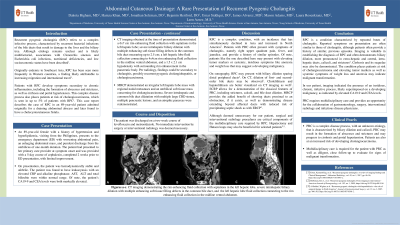Sunday Poster Session
Category: Biliary/Pancreas
P0126 - Abdominal Cutaneous Drainage: A Rare Presentation of Recurrent Pyogenic Cholangitis
Sunday, October 22, 2023
3:30 PM - 7:00 PM PT
Location: Exhibit Hall

Has Audio

Dakota Bigham, MD
University of Texas Health Science Center-San Antonio
San Antonio, TX
Presenting Author(s)
Dakota Bigham, MD1, James Alvarez, MD1, Laura Rosenkranz, MD2, Jonathan Selzman, DO2, Benjamin Heriford, DO2, Umar Siddiqui, DO1, Leen Azeez, BA1, Mason Adams, MD1
1University of Texas Health Science Center-San Antonio, San Antonio, TX; 2University of Texas Health Science Center at San Antonio, San Antonio, TX
Introduction: Recurrent pyogenic cholangitis is a complex disease process resulting in recurrent bacterial infections in the bile ducts leading to inflammation and damage to the liver and biliary system. The etiology is considered to be multifactorial, with associations observed with Clonorchis sinensis, and E. coli. Nutritional deficiencies, and low socioeconomic status have also been show to contribute. While rare in the Western world with a prevalence of approximately 1%, rates in East and Southeast Asia range from 18-45%. We present a rare case of recurrent pyogenic cholangitis in a patient admitted for a draining abdominal abscess, which was found to be related to a cholecystocutaneous fistula.
Case Description/Methods: An 89-year-old woman presented with increased spontaneous cutaneous drainage. The patient noticed erythema and purulence in her mid-abdomen a month ago, which improved with antibiotics. Subsequently, she developed recurrent drainage, prompting her to seek further evaluation. Imaging revealed a large rim-enhancing fluid collection with multiple septations in the left hepatic lobe, connected to the biliary tract. Additionally, the patient had a large rim-enhancing fluid collection with multiple septations within the midline ventral abdominal wall soft tissue, appearing to be connected to the hepatic lobe fluid collection. Core biopsies of the liver mass predominantly showed necrotic tissue and foci of mixed inflammation, with no evidence of a malignant process. Unfortunately, the patient elected to decline treatment and further workup due to her desire to return home to the Philippines. Infectious disease was consulted for antibiotic recommendations given the extensive infection burden and recommended levofloxacin and metronidazole for 2 weeks.
Discussion: Recurrent pyogenic cholangitis is a complex and challenging condition that affects the biliary system and liver. This case demonstrates an atypical and rare presentation of this disease process. For optimal patient care, multidisciplinary collaboration involving gastroenterologists, radiologists, infectious disease, and surgeons is crucial.

Disclosures:
Dakota Bigham, MD1, James Alvarez, MD1, Laura Rosenkranz, MD2, Jonathan Selzman, DO2, Benjamin Heriford, DO2, Umar Siddiqui, DO1, Leen Azeez, BA1, Mason Adams, MD1. P0126 - Abdominal Cutaneous Drainage: A Rare Presentation of Recurrent Pyogenic Cholangitis, ACG 2023 Annual Scientific Meeting Abstracts. Vancouver, BC, Canada: American College of Gastroenterology.
1University of Texas Health Science Center-San Antonio, San Antonio, TX; 2University of Texas Health Science Center at San Antonio, San Antonio, TX
Introduction: Recurrent pyogenic cholangitis is a complex disease process resulting in recurrent bacterial infections in the bile ducts leading to inflammation and damage to the liver and biliary system. The etiology is considered to be multifactorial, with associations observed with Clonorchis sinensis, and E. coli. Nutritional deficiencies, and low socioeconomic status have also been show to contribute. While rare in the Western world with a prevalence of approximately 1%, rates in East and Southeast Asia range from 18-45%. We present a rare case of recurrent pyogenic cholangitis in a patient admitted for a draining abdominal abscess, which was found to be related to a cholecystocutaneous fistula.
Case Description/Methods: An 89-year-old woman presented with increased spontaneous cutaneous drainage. The patient noticed erythema and purulence in her mid-abdomen a month ago, which improved with antibiotics. Subsequently, she developed recurrent drainage, prompting her to seek further evaluation. Imaging revealed a large rim-enhancing fluid collection with multiple septations in the left hepatic lobe, connected to the biliary tract. Additionally, the patient had a large rim-enhancing fluid collection with multiple septations within the midline ventral abdominal wall soft tissue, appearing to be connected to the hepatic lobe fluid collection. Core biopsies of the liver mass predominantly showed necrotic tissue and foci of mixed inflammation, with no evidence of a malignant process. Unfortunately, the patient elected to decline treatment and further workup due to her desire to return home to the Philippines. Infectious disease was consulted for antibiotic recommendations given the extensive infection burden and recommended levofloxacin and metronidazole for 2 weeks.
Discussion: Recurrent pyogenic cholangitis is a complex and challenging condition that affects the biliary system and liver. This case demonstrates an atypical and rare presentation of this disease process. For optimal patient care, multidisciplinary collaboration involving gastroenterologists, radiologists, infectious disease, and surgeons is crucial.

Figure: A. Coronal view of biliary anatomy
B. Coronal view of hepatic fluid collection in left lobe
C. Sagittal view displaying ventral abdominal soft tissue fluid collection
B. Coronal view of hepatic fluid collection in left lobe
C. Sagittal view displaying ventral abdominal soft tissue fluid collection
Disclosures:
Dakota Bigham indicated no relevant financial relationships.
James Alvarez indicated no relevant financial relationships.
Laura Rosenkranz indicated no relevant financial relationships.
Jonathan Selzman indicated no relevant financial relationships.
Benjamin Heriford indicated no relevant financial relationships.
Umar Siddiqui indicated no relevant financial relationships.
Leen Azeez indicated no relevant financial relationships.
Mason Adams indicated no relevant financial relationships.
Dakota Bigham, MD1, James Alvarez, MD1, Laura Rosenkranz, MD2, Jonathan Selzman, DO2, Benjamin Heriford, DO2, Umar Siddiqui, DO1, Leen Azeez, BA1, Mason Adams, MD1. P0126 - Abdominal Cutaneous Drainage: A Rare Presentation of Recurrent Pyogenic Cholangitis, ACG 2023 Annual Scientific Meeting Abstracts. Vancouver, BC, Canada: American College of Gastroenterology.
